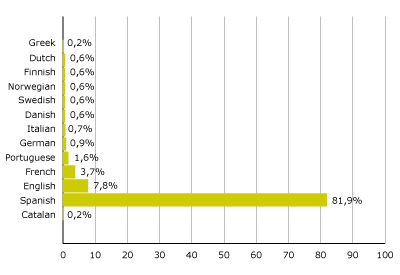
Multilingualism in labelling. Comparison of the situation and the linguistic policies regarding the labelling of products in linguistic communities with similar characteristics to Catalonia, by Bernat Gasull i Roig |
||||
| CONTINUA |
The policies of recognition of plurilingualism in Belgium and Switzerland are also well known. In both countries, the strict recognition of the different official languages by territorial areas guarantees the labelling in each language depending on the place of distribution. Belgium has a firm policy for recognition of languages. French, Dutch and German are official languages to all effects. Since the Constitution of 1993 there are three regions (Walloon, Flanders and Brussels) and 3 linguistic communities (French, Dutch and German). Each of these communities has far fewer speakers than the Catalan linguistic community in Spain. In the case of the German community it hardly reaches 80,000 speakers. Each community has all the rights to legislate and create independent policies that reign to all effects in every aspect that affects language. As for labelling, the Law of Commercial Practices and Information and Consumer Protection (18) dated July 14, 1991, establishes in Article 13 that products must at least be labelled the language or languages of the linguistic region where they are distributed; so that the presence of Dutch, French and German is guaranteed in the corresponding linguistic regions. Switzerland, with more than 6 million inhabitants, has a clear majority of German speakers (or speakers of Swiss dialects) with more than 73% of the population (4.5 million). There are about 1.3 million French speakers, 300,000 speak Italian and 50,000 Romansch. (19) Obviously the constitution (of 1848 but revised more than 140 times) recognises the four languages as national languages. Italian, German and French are official to all effects, and Romansh is official in relations with speakers of this language, although it is gaining more and more recognition. Switzerland is organised in monolingual, bilingual and trilingual cantons, with recognition of 4 linguistic areas that are in principle monolingual. As an example of applications in labelling resulting from the official recognition of multilingualism, we can quote the case of the Federal Law on Consumer Information of Switzerland dated October 5, 1990. (20) Article 2 obliged products to inform the consumer in the official languages of the country. This means, for example, the approximately 300,000 inhabitants of the canton of Ticino, even though they share the canton with a large German minority, have all products labelled in Italian. This protection of languages on the labels of products even occurs in very small linguistic communications, and specifically for a certain region, not as a state-wide regulation. In south Tyrol, where the labelling of food products is a reality, the Italian government went even further by promoting the Legislative Decree of May 2001, No. 283, (21) so that the Italian-German bilingualism is guaranteed in the instructions for pharmaceutical products in the province of Bolzano/Bozen included in the Autonomous Region of South Tyrol, and the Italian Ministry of Health must guarantee the content of the information in two languages. This Decree was issued in agreement with Presidential Decree 574 of 1988 and contains the penalties to be applied if, after a six-month period of adaptation and information, for example, citizens do not have the instructions for a pharmaceutical product in German. By considering the different European models we can affirm that, in comparison with the Catalan linguistic community, we cannot find in the European Union, and within countries with a democratic tradition and with economic development, any country with a comparable language regarding the number of speakers and vitality of use where this is not fully present on the labelling of all the basic products distributed within its territory. The Catalan linguistic community in Spain is an exception. Furthermore labelling the local language is extensively protected and guaranteed in some countries with linguistic communities with a far fewer number of speakers than Catalan. 3. Plurilingualism in the labelling of products in Catalonia: an exception situation In regard to the Catalan linguistic community we can see that: in the case of Spain, Companies which in comparable environments act by applying the respective codes or legislation that protects the consumers of this community, ignore their own codes, under the coverage, it is true, of a legal loophole in this area; or better said by legislation that only guarantees the rights of one part of the consumers in the state: those that belong to the community whose language is Spanish. Obviously, in Spain, plurilingualism in labelling exists, although the application is completely different from the linguistic options mentioned above. Let us consider some examples of this particular plurilingualism and then analyse the causes of this exceptional situation. In 1992, Joan Tudela, conducted a Study on the language of labelling, (22) where on the one hand, he compared the situation of Barcelona with Brussels, Zurich and Montreal, and at the same time analysed the use of languages on the labels of 50 products with large consumption in our country. In both cases the analysis of the languages did not only consider the presence, but also the space that they occupied on the label. The results were expressed according to the space that each language occupied, so that the total percentage for all languages was 100%. Graph 1 shows the languages on the labels of these 50 products in Barcelona. We insist that the variable was the space for each language on the label, not the percentage of products labelled in that language. It is interesting to compare the two official languages, and the difference with the local language. As an example, in Barcelona Catalan occupied the same space as Greek. Graph 1. Space occupied by each language in the labelling of 50 large consumption products in Barcelona. 1992 (Tudela, J.)
|
||
